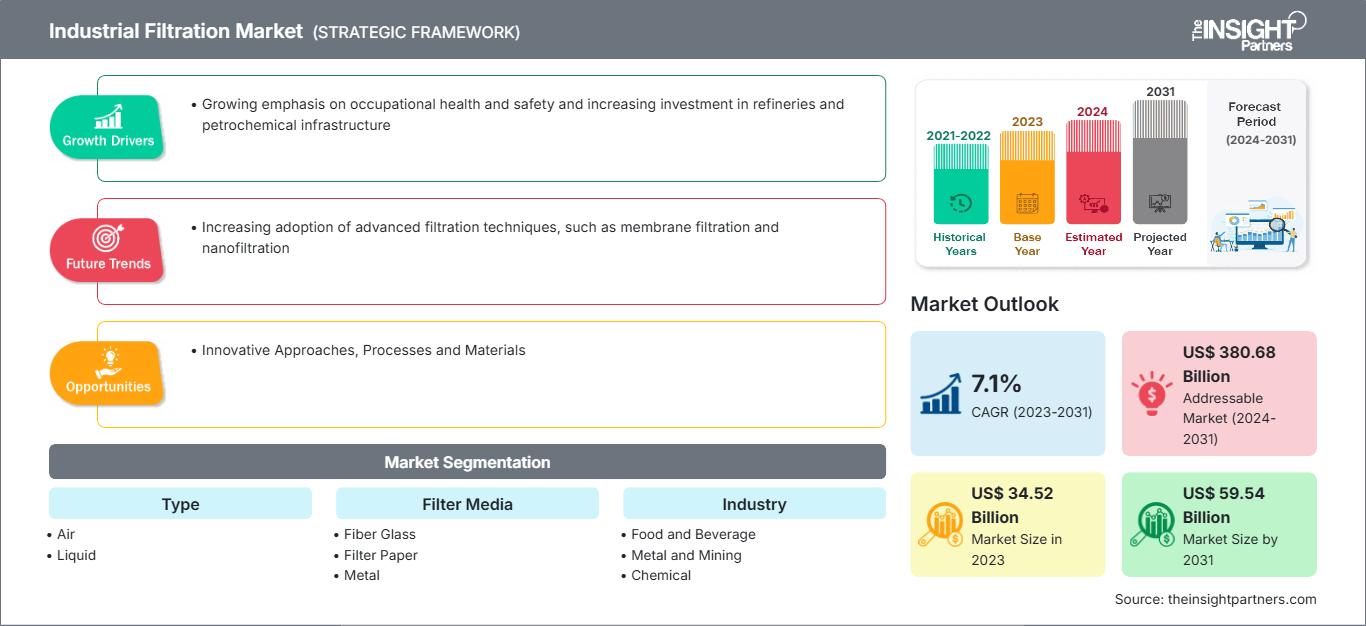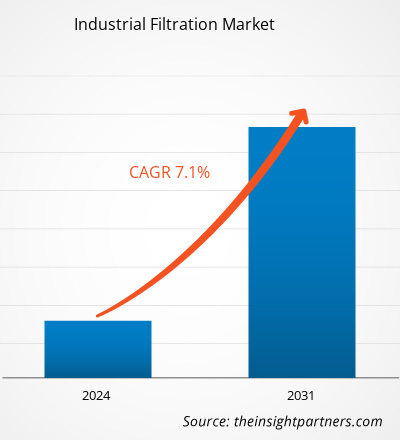Si prevede che il mercato della filtrazione industriale raggiungerà i 59,54 miliardi di dollari entro il 2031, rispetto ai 34,52 miliardi di dollari del 2023. Si prevede che il mercato registrerà un CAGR del 7,1% tra il 2023 e il 2031. La crescente adozione di tecniche di filtrazione avanzate, come la filtrazione a membrana e la nanofiltrazione, rimarrà probabilmente una tendenza chiave nel mercato.
Analisi del mercato della filtrazione industriale
Negli ultimi anni, il mercato della filtrazione industriale ha registrato una crescita significativa. Fattori come la crescente industrializzazione e urbanizzazione, l'aumento delle attività industriali, la crescente attenzione alla salute e sicurezza sul lavoro e la crescente consapevolezza e regolamentazione in materia di sostenibilità ambientale sono alcuni dei fattori che guidano la crescita del mercato della filtrazione industriale. Approcci, processi e materiali innovativi offrivano opportunità di crescita redditizie per il mercato della filtrazione industriale.
Panoramica del mercato della filtrazione industriale
La filtrazione industriale si riferisce a un processo attraverso il quale le industrie filtrano i loro prodotti da detriti e residui, nonché da altri prodotti di scarto. La filtrazione industriale si concentra sull'essiccazione dei rifiuti per uno smaltimento sicuro e sulla raffinazione del prodotto finale. La filtrazione è essenziale per vari settori come l'estrazione mineraria, il gas naturale, la gestione dei rifiuti liquidi, l'acqua, il confezionamento di alimenti e bevande, la produzione di energia rinnovabile e altri. I filtri industriali sono di vario tipo, classificati in base alle loro caratteristiche meccaniche e fisiche. Alcuni di questi filtri industriali sono filtri a gravità, filtri a pressione/vuoto, filtri a foglia, filtri a vuoto a tamburo rotante e altri.
Personalizza questo rapporto in base alle tue esigenze
Potrai personalizzare gratuitamente qualsiasi rapporto, comprese parti di questo rapporto, o analisi a livello di paese, pacchetto dati Excel, oltre a usufruire di grandi offerte e sconti per start-up e università
Mercato della filtrazione industriale: Approfondimenti strategici

-
Ottieni le principali tendenze chiave del mercato di questo rapporto.Questo campione GRATUITO includerà l'analisi dei dati, che vanno dalle tendenze di mercato alle stime e alle previsioni.
Fattori trainanti e opportunità del mercato della filtrazione industriale
Crescente attenzione alla salute e alla sicurezza sul lavoro per favorire il mercato
Nel dinamico mondo odierno, garantire il benessere dei lavoratori è fondamentale. Un ambiente di lavoro sicuro è fondamentale per un ambiente sano e favorisce anche una maggiore produttività e una migliore reputazione aziendale. Garantire la sicurezza sul posto di lavoro implica l'implementazione di diverse misure preventive, politiche e procedure di sicurezza per ridurre al minimo infortuni, incidenti e malattie professionali. Per garantire la sicurezza sul posto di lavoro, diversi settori, come quello manifatturiero, minerario, farmaceutico e altri, hanno investito sempre più in tecnologie di filtrazione avanzate per salvaguardare la propria forza lavoro da particelle, sostanze chimiche e fumi nocivi.
Approcci, processi e materiali innovativi
I guasti alle macchine rappresentano uno dei maggiori problemi di produzione che i produttori devono affrontare. Contaminanti come polvere, scorie di saldatura, nebbie oleose, particelle di gomma provenienti da tubi e guarnizioni, sabbia da fusioni e detriti metallici provenienti da componenti lavorati sono le principali cause di guasti alle macchine. Sia i costi di riparazione che i tempi di fermo macchina sono elevati. Poiché i consumatori sono diventati sempre più consapevoli dell'impatto negativo dei contaminanti, vi è una crescente domanda di processi e prodotti migliorati che contribuiscano a ridurre i tempi di fermo macchina, aumentare la durata dei lubrificanti e ridurre i costi. In tale scenario, le aziende stanno implementando sempre più progressi nella filtrazione in tre aree: design dei filtri più durevoli, materiali ad alte prestazioni e monitoraggio automatico dei filtri (Internet of Things) per affrontare queste problematiche.
Analisi della segmentazione del rapporto di mercato della filtrazione industriale
I segmenti chiave che hanno contribuito alla derivazione dell'analisi del mercato della filtrazione industriale sono la tipologia, i media filtranti e il settore.
- In base alla tipologia, il mercato della filtrazione industriale è suddiviso in aria e liquidi. Il segmento dell'aria ha detenuto una quota di mercato maggiore nel 2023.
- In base ai materiali filtranti, il mercato è segmentato in fibra di vetro, carta da filtro, metallo e tessuto non tessuto. Il segmento del tessuto non tessuto ha detenuto la quota di mercato maggiore nel 2023.
- In termini di settore, il mercato è segmentato in alimentare e delle bevande, metallurgico e minerario, chimico, farmaceutico, produzione di energia e altri. Si prevede che il segmento alimentare e delle bevande crescerà con il CAGR più elevato nel periodo di previsione.
Analisi della quota di mercato della filtrazione industriale per area geografica
L'ambito geografico del rapporto sul mercato della filtrazione industriale è suddiviso principalmente in cinque regioni: Nord America, Asia-Pacifico, Europa, Medio Oriente e Africa e Sud e Centro America.
La regione europea del mercato della filtrazione industriale è destinata a registrare una crescita significativa nel prossimo futuro. L'Europa è stata in prima linea nell'implementazione di rigorose normative e standard ambientali per ridurre l'impatto delle emissioni industriali. Queste normative enfatizzano l'utilizzo di materiali non tossici, la modifica dei metodi di produzione e le tecniche di conservazione. Di conseguenza, le industrie europee stanno adottando sempre più sistemi di filtrazione industriale per conformarsi a queste normative e ridurre l'inquinamento, trainando così il mercato regionale della filtrazione industriale.
Approfondimenti regionali sul mercato della filtrazione industriale
Le tendenze regionali e i fattori che influenzano il mercato della filtrazione industriale durante il periodo di previsione sono stati ampiamente spiegati dagli analisti di The Insight Partners. Questa sezione illustra anche i segmenti e la geografia del mercato della filtrazione industriale in Nord America, Europa, Asia-Pacifico, Medio Oriente e Africa, America meridionale e centrale.
Ambito del rapporto sul mercato della filtrazione industriale
| Attributo del rapporto | Dettagli |
|---|---|
| Dimensioni del mercato in 2023 | US$ 34.52 Billion |
| Dimensioni del mercato per 2031 | US$ 59.54 Billion |
| CAGR globale (2023 - 2031) | 7.1% |
| Dati storici | 2021-2022 |
| Periodo di previsione | 2024-2031 |
| Segmenti coperti |
By Tipo
|
| Regioni e paesi coperti |
Nord America
|
| Leader di mercato e profili aziendali chiave |
|
Densità degli operatori del mercato della filtrazione industriale: comprendere il suo impatto sulle dinamiche aziendali
Il mercato della filtrazione industriale è in rapida crescita, trainato dalla crescente domanda degli utenti finali, dovuta a fattori quali l'evoluzione delle preferenze dei consumatori, i progressi tecnologici e una maggiore consapevolezza dei vantaggi del prodotto. Con l'aumento della domanda, le aziende stanno ampliando la propria offerta, innovando per soddisfare le esigenze dei consumatori e sfruttando le tendenze emergenti, alimentando ulteriormente la crescita del mercato.

- Ottieni il Mercato della filtrazione industriale Panoramica dei principali attori chiave
Notizie e sviluppi recenti sul mercato della filtrazione industriale
Il mercato della filtrazione industriale viene valutato raccogliendo dati qualitativi e quantitativi a seguito di ricerche primarie e secondarie, che includono importanti pubblicazioni aziendali, dati di associazioni e database. Di seguito sono elencati alcuni degli sviluppi nel mercato della filtrazione industriale:
- Pall Corporation, rinomato leader mondiale nel mercato della filtrazione industriale e nelle tecnologie di separazione e purificazione, presenterà la sua tecnologia di filtrazione e purificazione di nuova generazione al SEMICON West. Questa mossa strategica è in linea con la crescente domanda di chip avanzati con prestazioni ed efficienza energetica migliorate, trainata dalla crescente adozione di dispositivi 5G, AI e IoT. (Fonte: Pall Corporation, comunicato stampa, luglio 2023)
- MANN+HUMMEL Group, leader mondiale nelle soluzioni di filtrazione, ha recentemente acquisito una quota di maggioranza di Suzhou U-Air Environmental Technology. Questa mossa strategica è guidata dalla crescente domanda globale di soluzioni per un'aria più pulita e mira a rafforzare la presenza di MANN+HUMMEL nel mercato cinese e del Sud-est asiatico della filtrazione dell'aria. L'acquisizione di Suzhou U-Air Environmental Technology consente a MANN+HUMMEL di ampliare il proprio portafoglio prodotti e soddisfare la crescente domanda di soluzioni per la filtrazione dell'aria nella regione. (Fonte: Gruppo MANN+HUMMEL, Comunicato stampa, ottobre 2023)
Copertura e risultati del rapporto sul mercato della filtrazione industriale
Dimensioni e previsioni del mercato della filtrazione industriale (2021-2031) Il rapporto fornisce un'analisi dettagliata del mercato che copre le seguenti aree:
- Dimensioni e previsioni del mercato della filtrazione industriale a livello globale, regionale e nazionale per tutti i principali segmenti di mercato coperti dall'ambito
- Tendenze del mercato della filtrazione industriale, nonché dinamiche di mercato come fattori trainanti, vincoli e opportunità chiave
- Analisi dettagliata delle cinque forze PEST/Porter e SWOT
- Analisi del mercato della filtrazione industriale che copre le principali tendenze del mercato, il quadro globale e regionale, i principali attori, le normative e i recenti sviluppi del mercato
- Analisi del panorama industriale e della concorrenza che copre la concentrazione del mercato, l'analisi della mappa termica, i principali attori e i recenti sviluppi per il mercato della filtrazione industriale
- Profili aziendali dettagliati
- Analisi storica (2 anni), anno base, previsione (7 anni) con CAGR
- Analisi PEST e SWOT
- Valore/volume delle dimensioni del mercato - Globale, Regionale, Nazionale
- Industria e panorama competitivo
- Set di dati Excel
Report recenti
Testimonianze
Motivo dell'acquisto
- Processo decisionale informato
- Comprensione delle dinamiche di mercato
- Analisi competitiva
- Analisi dei clienti
- Previsioni di mercato
- Mitigazione del rischio
- Pianificazione strategica
- Giustificazione degli investimenti
- Identificazione dei mercati emergenti
- Miglioramento delle strategie di marketing
- Aumento dell'efficienza operativa
- Allineamento alle tendenze normative






















 Ottieni un campione gratuito per - Mercato della filtrazione industriale
Ottieni un campione gratuito per - Mercato della filtrazione industriale